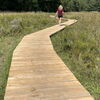Maine needs TIFs that would benefit communities, businesses and workers
 Jennifer McKenna
Jennifer McKenna
Many Maine communities use Tax Increment Financing to provide incentives to corporations and developers to attract new jobs and jumpstart major construction projects, from business parks to hotels to condominiums. TIFs work by deferring property tax assessments and other levies for a specific time period.
Municipal development officers reason that the real estate will gain value and produce higher tax revenue in the future and may even raise the property values of surrounding buildings and lots. The idea is to give up a little now, so cities and towns can reap higher payments in the future.
Even when TIFs work as intended, they don't work as well as they could for Maine's construction workers.
When we think about TIFs, here's a better way to encourage wider and more long-lasting benefits for all — our communities, businesses and developers and Maine workers. After all, TIFs only work well in partnership, so why not invite all of the partners to the table?
Right now, municipal governments and developers strike a deal for reduced property taxes in exchange for new jobs and construction. Opportunities to invest in worker training and local hiring get left out. That significantly devalues what TIFs can accomplish.
Rather, businesses and developers receiving a TIF should meet some modest conditions.
- Hire local: That's not just being a good corporate neighbor. Hiring local will help Maine stem the tide of young people moving away in search of other opportunities. Local governments writing TIFs should include a provision that requires a certain percentage of jobs created be filled by local residents — say, within a radius of 50 miles.
- Train or retrain locally: This goes hand-in-hand with hiring local. Again, write a condition into the TIF that requires investment in job training. Generating new job opportunities for young Mainers and matching skills training will help communities throughout Maine retain younger workers. That's especially important as Maine's workforce ages. In fact, displaced workers who are reaching middle age could also benefit from training programs. They've already proven their work ethic, but they need to update skills or acquire new ones to keep earning.
There's another way TIFs could benefit Maine communities, businesses and workers.
With new construction booming in southern Maine and new jobs being created by expanding businesses or others relocating to Maine, now is the time to use new thinking about TIFs.
Maine is expected to see its working-age population drop by 16% between 2010 and 2040, according to a Pew Charitable Trusts report released in May. Maine is already the nation's oldest state, with a median age of 43.5. Skilled construction workers are even older, with the average age nearly 50.
As Maine's workforce shrinks, it will be vitally important to focus on the skilled workers who are ready to fill construction jobs and on expanding registered apprentice training. The benefits speak for themselves. For skilled workers, it's to get good-paying jobs with benefits to round out their working lives. For younger workers, it would be a chance to earn and learn skills on the job that will provide lifelong careers, without crushing college debt.
All of this goes into fresh thinking about how to use TIFs. Writing TIFs with a full circle approach is not a silver bullet, by any means. But it will go a long way toward supplying businesses with the trained, skilled workers they need, while giving Maine's working families income security and a step up to the middle class. At the same time, hiring and training local will inject new revenue and confidence into our local economies.
This is a partnership that works for all — communities, developers, businesses and workers. Partnerships like these can work to build the future we want in Maine.










Comments